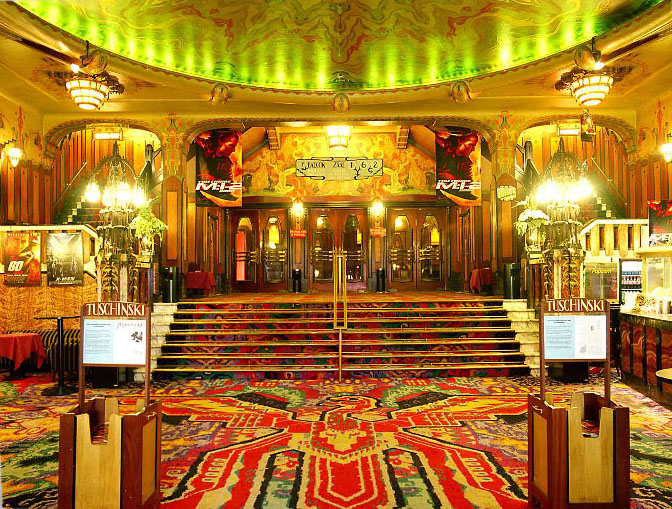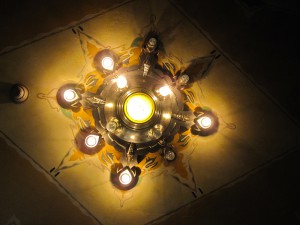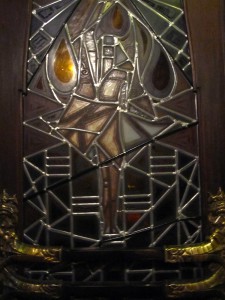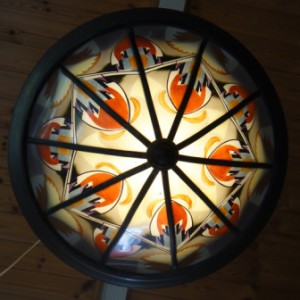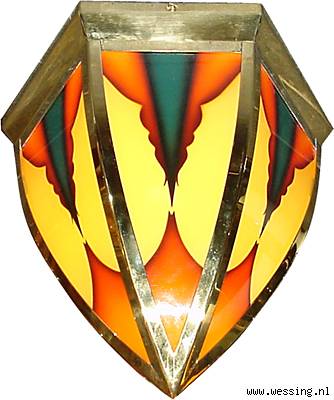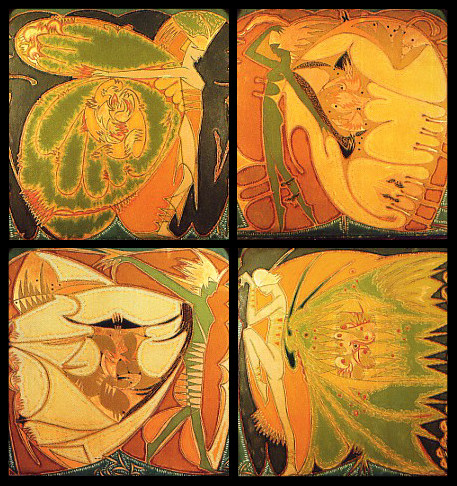The first time I went to the Tuschinksi theater I must have been somewhat around 10 years old. It made a huge impression on me, between all the ugly stores and cheap restaurants, a beautiful building with butterfly cocoons and metal trees.
Remembering this I decided to rediscover this building when we got the assignment on the “Wendingen” magazines.
So with my camera I went there, the building was still as impressive (looking a bit smaller though) and from the entrance to the loge it was a real joy. There is so much detail at first it looks like scribbling, but after a while I could focus on individual parts of the interior. Behind the bar there are three heads, enlisted by glass birds in blue and yellow. The walls mostly covered by paintings and endless woodwork. And the many lamps, in all possible shapes. Mostly they look like stylized insects.
But when I asked a lady if she maybe had some information on the theater and the lamps and glass-work specifically, she told me no. Also, sadly, I could not go past the entrance hall. Luckily I was allowed to take some pictures [x].
All the interior is made by hand, and not one single thing has escaped the all-seeing eye of Abraham Tuschinski.
He spend a fortune on this project, and refused to use any other than the finest woods, glass and metals for the interior of his little pearl.
To me the most attractive part is that of the the lamps, made from stained glass with sometimes up to a 150 different panels. The stained-glass in the Tuschinksi-cinema was originally designed by Pieter den Besten.
Three companies had to be hired to do the job. Degens, Warffemius and Winkelman. Degens glass- and mirror factory, situated in Rotterdam, this company was founded in 1901 and is still in business. There is also not a lot to find on Warffemius except for a reference in a report on monumental art on the fact that he made a glass-panel for the Feijenoord stadium in Rotterdam. His stained-glass however pops up in a lot of art auctions en still seem to be quite demanded. Mostly these are glass-pieces with animal shapes on them. Winkelman had then already worked and would proceed to work together with architects from the Amsterdam School like Piet Kramer and Adriaan Moen. Some examples of well-known buildings he worked on are the iron fences at the ‘Scheepvaarthuis’ and the stained-glass in the Bethlehem church in Amsterdam North. Besides glass and iron, Winkelman also made furniture and some clocks in the style of ‘de Stijl’.[more clocks]
The designs are primarily made out of geometrical shapes, mostly abstract. There are however some bigger pieces that show stylized birds and flora. It is funny to see how many of the objects in the theatre are quite opposite to the strict rules the later Amsterdam school would want his relatives to embrace. If you would like to see more of Pieter den Besten’s design-work the Grand Cafe Central in Gouda is a good option. When the cafe was renovated in 1992, den Besten’s painting were rediscovered and the current owner decided to restore them. The cafe is now a monument, and with it’s stained glass windows, the wall-paintings of stylized ladies and orange/brown/green pallet a great art-deco treasure.
Christiaan Bartels carried the responsibility for the lamps of the interior, looking for more information on this specific style I discovered they are simply called ‘Tuschinksi-lamps’ and are still sold and made under that same name. There is no other genre the lightning in the theatre could be put under. The lamps are made out of seemingly simple rectangles, and lines on stained glass. The design was ahead of it’s time, considering this was of the very beginning of the art-deco movement. Also the way the electricity was done was very innovative. One of the most impressive pieces is the plafonnière in the big venue, it consists of almost 650 panels. I looks as if the lights disappears into the woodwork shaped like some strange bird-like creature done by Jaap Gidding. Although the designers did not just carry responsibility for these tasks, even did not execute most of their designs themselves (Duchateau from Rotterdam executed the work for the lightning in the theatre), it still seems like big job to get done.
Coming from a poor environment himself, Tuschinski mainly build the theatre from an socialistic point of view. He felt everybody deserved the luxury, both literally and figuratively speaking, of having a fun and careless evening. In fact, a lot of the architects of that time had a social preference when it came to politics.
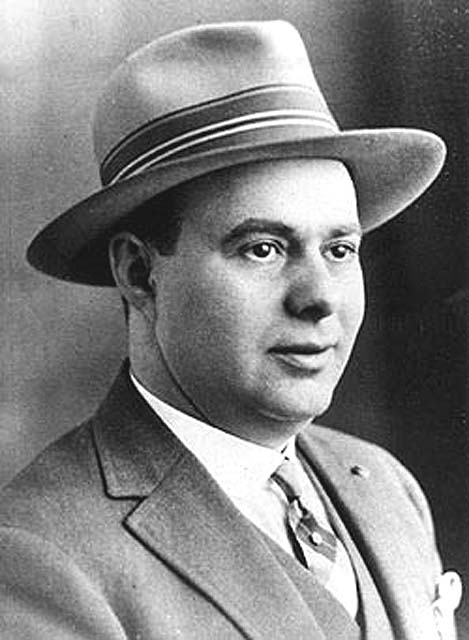

A lot happened since the first grand opening, in 1935 Tuschinski and his companions faced some serious money problems and lost their ownership and a lot of the magnificent art on the walls got covered under more practical paint. But there was a much greater tragedy to follow. In 1939 the nazi’s take ownership of the theatre, and the jewish Abraham Tuschinski is deported to Westerbork and from there to Auschwitz, from where he would never return.
In the year 2000 the theatre got completely renovated. The lamps were designed by Robert Jan Vos and Rienk Visser together with Anthonie Koolen glazeniers who executed the stained glass and also the big ‘spiderweb’ lamp.
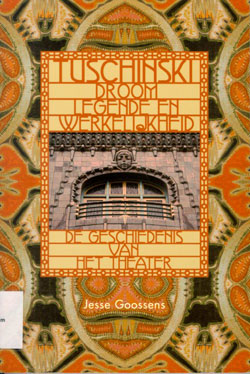 For more general information on Tuschinksi, both person and theatre http://www.jessegoossens.nl/ (Tuschinski. Droom, Legende en Werkelijkheid.)
For more general information on Tuschinksi, both person and theatre http://www.jessegoossens.nl/ (Tuschinski. Droom, Legende en Werkelijkheid.)
